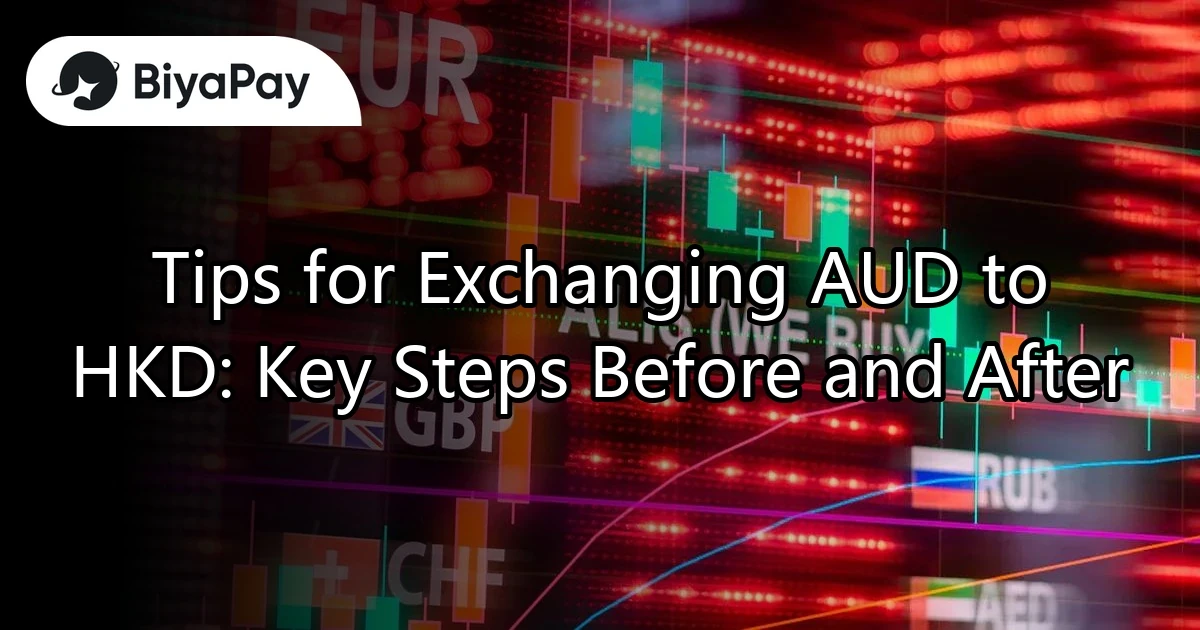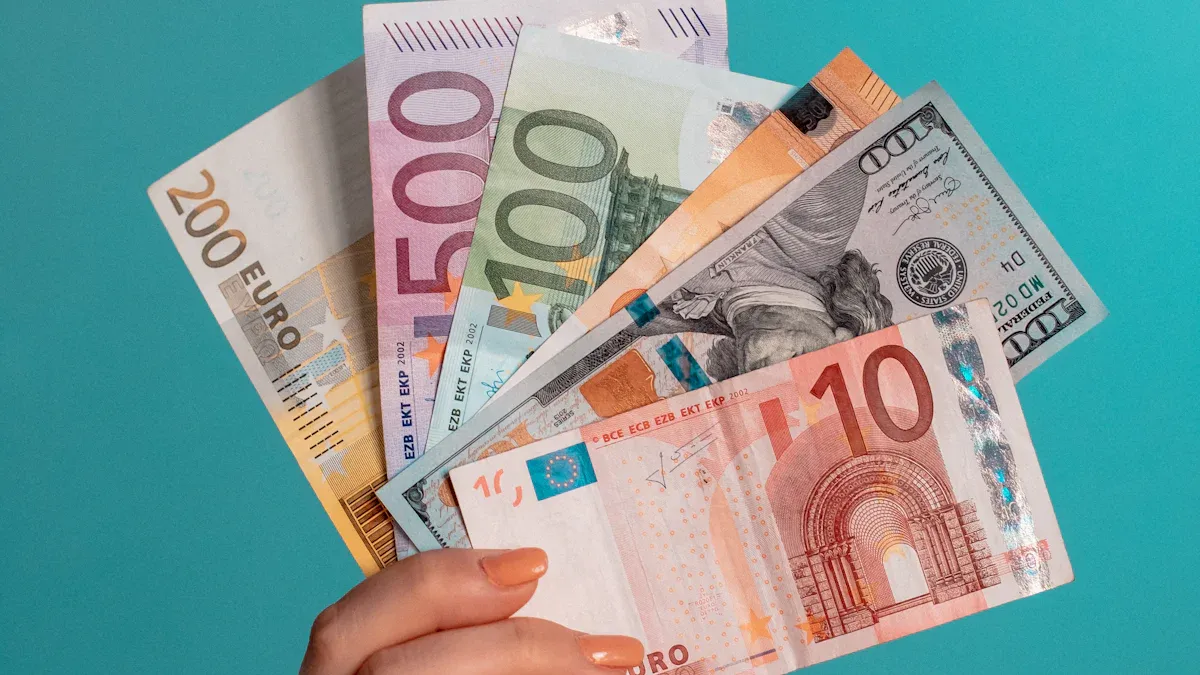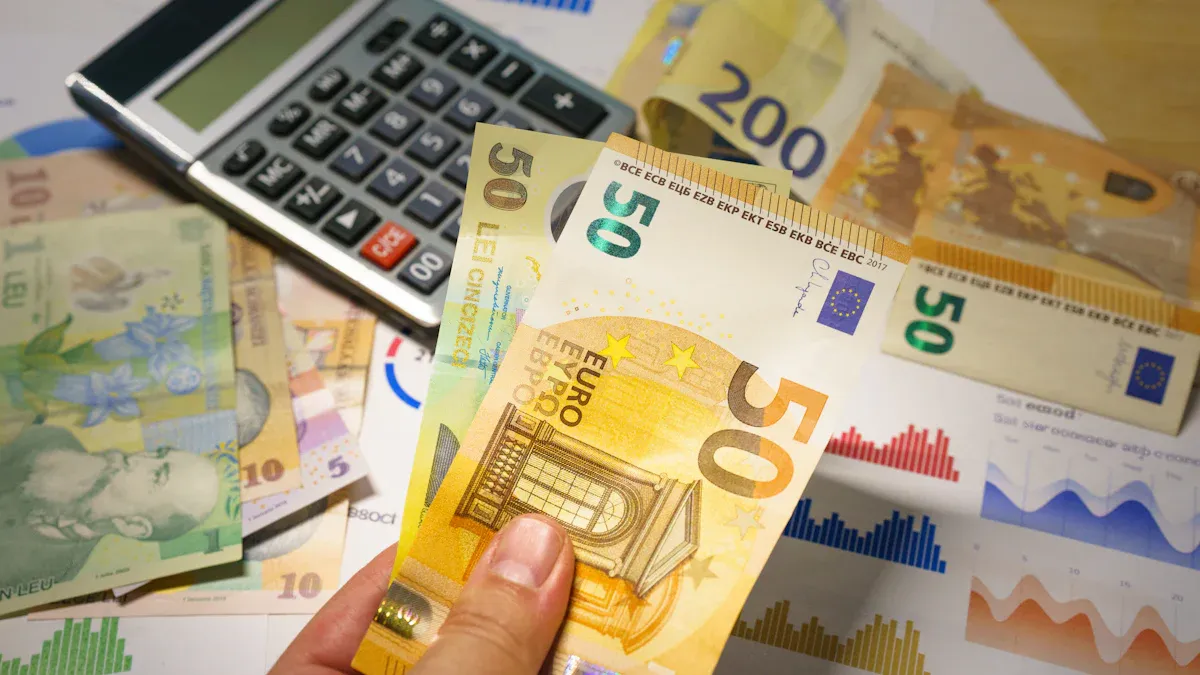- EasyCard
- Trade
- Help
- Announcement
- Academy
- SWIFT Code
- Iban Number
- Referral
- Customer Service
- Blog
- Creator
Tips for Exchanging AUD to HKD: Key Steps Before and After

Image Source: pexels
Do you want to exchange AUD to HKD cost-effectively? You can compare exchange rates and fees at money changers, Hong Kong banks, ATMs, and online platforms. The table below shows the convenience and recommendation level of each channel. Before and after exchanging, you should pay attention to exchange rate fluctuations, document preparation, and cash safety.
| Exchange Method | Rate Advantage | Fees | Convenience | Recommendation |
|---|---|---|---|---|
| Money Changer | None | Yes | Fast | Moderately Recommended |
| Hong Kong Bank Counter | None | Yes | Limited by Business Hours | Least Recommended |
| Online Platform | Usually Yes | Yes/No | Flexible | Most Recommended |
| ATM Withdrawal | Usually Yes | None | 24-Hour Access | Moderately Recommended |
Key Points
- Before exchanging, compare exchange rates and fees across channels to choose the most cost-effective method, avoiding increased costs due to rate differences and fees.
- When choosing an exchange channel, consider safety, convenience, and rate quality. Online platforms typically offer the best rates and low fees, banks are suitable for large amounts, and money changers are good for small cash amounts.
- When exchanging, use a simple formula to calculate the actual HKD received: Actual HKD = AUD Amount × Exchange Rate - Fees. Verify receipts and securely store cash to ensure fund safety.
Pre-Exchange Preparation
Exchange Rate Comparison
Before exchanging AUD to HKD, you should first compare exchange rates across different channels. Exchange rates fluctuate daily, affecting the final amount you receive. You can refer to the table below to understand the impact of rate changes on exchange costs:
| Item | Value Description |
|---|---|
| Central Bank Mid-Rate | 6.1 (CNY to USD) |
| Rate Fluctuation Range | ±2% |
| Highest Rate | 6.222 |
| Lowest Rate | 5.978 |
| Exchange Amount (10,000 USD) | Highest: 62,220 CNY, Lowest: 59,780 CNY |
| Difference Due to Rate Fluctuation | 2,440 CNY |
You can use this method to calculate exchange amounts under different rates. It’s recommended to compare rates from Hong Kong banks, money changers, ATMs, and online platforms to choose the most favorable timing and channel.
Fee Inquiry
When exchanging, different channels charge varying fees. Some money changers charge fixed fees, while some banks calculate fees as a percentage. ATMs and online platforms may sometimes waive fees but could have rate differences. You should check each channel’s fee structure and calculate total costs to avoid exceeding your budget due to fees.
Tip: You can directly inquire with banks or money changers or check the latest fee information on online platforms.
Documents and Booking
When exchanging large amounts of AUD, Hong Kong banks and some money changers may require identification documents. You should prepare your ID card or passport in advance. Some banks or online platforms require prior booking to ensure a smooth exchange process. You can call the relevant institution to confirm required documents and booking procedures to avoid last-minute hassles.
Exchange Channel Selection

Image Source: unsplash
When exchanging AUD to HKD, you can choose different channels. Each channel has varying safety, rates, fees, and use cases. You can refer to the table below for a quick overview of each channel’s key features:
| Exchange Channel | Safety Considerations | Rate Features | Fee Structure | Usage Suggestions |
|---|---|---|---|---|
| Bank Card (e.g., HSBC, Citibank) | Relies on bank and ATM network logos for safety | Rates include markup (up to ~2.4%), differing from mid-market rates | HSBC waives foreign transaction fees, but non-HSBC ATM withdrawals incur fees; Citibank waives overseas transaction fees, but unsupported currencies incur an extra 1.95% fee | Suitable for account holders, convenient and safe for overseas withdrawals |
| Money Changer | High convenience, but less secure than banks; choose reputable shops | Rates typically worse than banks and online platforms, cash rates more expensive than telegraphic transfers | Most don’t charge fixed fees, but rate spreads are larger | Suitable for short-term travel to exchange enough cash, compare rates carefully |
| ATM Withdrawal | Relies on ATM network logos and bank security measures | Rates set by international card organizations, with small rate spreads | Hong Kong bank fees ~20-60 HKD, overseas banks may charge extra | Suitable for international debit card holders, convenient for overseas cash withdrawals |
| Online Platform (e.g., Wise, Revolut) | Holds financial licenses, high safety | Rates close to mid-market, minimal rate spreads | Wise charges transparent fees; Revolut free accounts have fee-free limits, 1% fee beyond limits | Suitable for frequent remittances and exchanges, saves on fees and rate spreads |
Tip: You can use tools like TTRate.com to check real-time rates and fees, helping you choose the most cost-effective channel.
Money Changers
When choosing a money changer, you can exchange cash instantly, and the process is quick. You only need to bring identification documents, and no booking is usually required. Money changers’ rates are slightly worse than banks but better than some ATMs. Most don’t charge fixed fees but profit through rate spreads. You should choose reputable money changers and avoid exchanging in remote locations for safety. Money changers are suitable for small cash amounts or when you need HKD urgently.
Note: When exchanging large amounts of cash, consider doing so in batches and stay mindful of on-site safety.
Banks
When exchanging AUD to HKD at Hong Kong banks, safety is the highest. Banks are strictly regulated, ensuring your funds’ security. Bank rates are typically worse than money changers and online platforms, and they charge fees. You need to bring identification documents, and some banks require booking. Banks are suitable for large-amount exchanges or when transferring to an account. Bank operating hours are limited, and the exchange process is slower.
Suggestion: For exchanges exceeding USD 5,000, prioritize banks to ensure fund safety.
ATM Withdrawals
If you hold an international bank card, you can withdraw HKD directly from ATMs in Hong Kong or overseas. ATMs rely on bank and international networks (e.g., PLUS, Cirrus), offering high safety. ATM rates are set by international card organizations, usually better than bank counters but with small rate spreads. Hong Kong bank ATM fees are ~USD 2.5–7.5 (at 1 USD = 7.8 HKD), and overseas banks may charge extra. ATMs are suitable when you need cash urgently or prefer not to carry large amounts of cash.
Tip: Check your bank card’s overseas withdrawal fees to avoid unnecessary expenses.
Online Platforms
When choosing online platforms (e.g., Wise, Revolut), you can enjoy rates close to the mid-market with minimal spreads. These platforms hold financial licenses, ensuring high safety. Wise charges transparent fees, while Revolut’s free accounts have fee-free limits, with a 1% fee beyond that. You can operate anytime, anywhere via mobile or computer, making it fast and suitable for frequent exchanges or remittances. Online platforms are ideal for small to medium amounts or when you need flexible operations.
Note: Confirm whether the platform supports AUD and HKD exchanges and check daily limits.
AUD to HKD Calculation

Image Source: pexels
Exchange Rate Calculation Method
Do you want to know the correct method for calculating AUD to HKD? You can use a simple formula to calculate how much HKD you’ll actually receive. You only need three numbers: the AUD amount to exchange, the exchange rate, and any fees.
Calculation steps are as follows:
- Check the real-time rate of your chosen channel. For example, 1 AUD = 5.2 HKD.
- Decide the AUD amount to exchange. For example, you want to exchange USD 1,000 (assuming 1 USD = 1.5 AUD, ~1,500 AUD).
- Use this formula to calculate:
Actual HKD = AUD Amount × Exchange Rate - Fees - Assuming a fee of USD 10 (~15 AUD), you can calculate:
- First, calculate HKD before fees: 1,500 × 5.2 = 7,800 HKD
- Subtract fees (in HKD): USD 10 × 7.8 = 78 HKD
- Final actual HKD: 7,800 - 78 = 7,722 HKD
You can use this method to quickly complete AUD to HKD calculations. Before each exchange, it’s recommended to use a calculator or mobile app to estimate, ensuring the received amount meets expectations.
Tip: You can use online exchange rate calculators, inputting AUD amount and rate, and the system will automatically calculate actual HKD, making it convenient and accurate.
Rate Spreads and Costs
When calculating AUD to HKD, besides the rate, pay special attention to rate spreads and fees. These factors directly affect the HKD you ultimately receive.
- Rate Spreads: Different channels have varying rates. Money changers, banks, ATMs, and online platforms all differ. Choosing a channel with worse rates significantly reduces your received amount.
- Fees: Some channels charge fixed fees, others percentage-based. Calculate total costs, not just rates.
You can refer to the table below to compare actual costs across channels:
| Channel | Rate (1 AUD = ? HKD) | Fee (USD) | Actual HKD for USD 1,000 (~1,500 AUD) |
|---|---|---|---|
| Money Changer | 5.15 | 5 | 1,500 × 5.15 - 39 = 7,736 |
| Hong Kong Bank | 5.10 | 10 | 1,500 × 5.10 - 78 = 7,572 |
| ATM Withdrawal | 5.18 | 7 | 1,500 × 5.18 - 54.6 = 7,716 |
| Online Platform | 5.20 | 3 | 1,500 × 5.20 - 23.4 = 7,776 |
You can see that a 0.01 rate difference results in a 15 HKD gap for 1,500 AUD. High fees further reduce the received amount. When calculating AUD to HKD, always consider both rate and fees.
Note: For large amounts, rate spreads and fees have a greater impact. Compare multiple channels to choose the lowest total cost option.
Each time you calculate AUD to HKD, remember to:
- Check real-time rates
- Clarify fees
- Use the formula to calculate actual amount
- Compare multiple channels
This way, you can exchange cost-effectively for the most HKD.
During Exchange Considerations
Locking in Rates
When exchanging AUD to HKD, rates often fluctuate. You should choose channels that allow rate locking. Some online platforms and Hong Kong banks offer real-time rate-locking services. Before confirming the transaction, you can see the final rate, avoiding losses due to market fluctuations. Lock in rates when they are high to get more HKD. For large amounts, locking rates is especially important. You can use mobile apps or online platforms to check and lock rates anytime, reducing uncertainty.
Tip: Set rate alerts to exchange instantly when rates reach your desired level, seizing the best opportunity.
Avoiding Hidden Fees
When exchanging, besides obvious fees, beware of hidden charges. Some money changers or platforms may include extra costs in rates, shipping, or other service fees. You should review all fee details to avoid receiving less than expected. According to statistics from the Consumer Foundation and Criminal Police Bureau’s 165 Anti-Fraud Hotline, hidden fee issues are common, significantly impacting exchange costs:
- Most providers still charge original order shipping fees when consumers return all items, increasing actual exchange costs.
- Complaints show that after returns reduce order amounts to zero, providers offset return shipping with original shipping fees, resulting in non-full refunds.
- Current consumer protection laws don’t clearly regulate whether original shipping fees should be borne by consumers, leading to varying fee rules.
- In high-risk marketplace cases, canceling installment payments and fake online shopping are major fraud types, with significant case volumes, indicating widespread hidden fee issues affecting exchange costs.
You should choose transparent platforms or Hong Kong banks and request a full fee breakdown before transactions. Keep transaction records for future reference. If you encounter unreasonable fees, inquire or complain to relevant institutions promptly to protect your rights.
Post-Exchange Actions
Receipt Verification
After exchanging, immediately verify the receipt’s contents. Check if the amount, rate, fees, and date are correct. The receipt is crucial for future inquiries or complaints. You can take a photo of the receipt to avoid losing the original. If you find errors, promptly report them to the Hong Kong bank or money changer staff for quick resolution.
Cash Storage
After receiving cash, store it securely. According to relevant regulations, financial institutions must establish monitoring and remediation systems to record and report cash errors, damage, or losses. You should store cash separately and avoid carrying large amounts when going out. If cash is lost or damaged, retain relevant proof and notify the bank or relevant institution promptly. This ensures your funds’ safety.
Amount Limits
When exchanging in Hong Kong, some channels impose limits on single or daily exchange amounts. For example, some Hong Kong banks cap daily exchanges at USD 10,000, while money changers may have lower limits. You should check regulations in advance to avoid transaction rejections due to exceeding limits. For large amounts, consider exchanging in batches to ensure a smooth process.
Record Keeping
You should maintain comprehensive exchange records. You can follow these practices:
- Use your phone or computer to record each exchange’s amount, rate, and fees.
- Save all receipts and electronic transaction records for future verification.
- Periodically organize records to check for anomalies or omissions.
- If needed, upload records to the cloud for safety and completeness.
These measures help you track exchange activities, improve management efficiency, and reduce errors or omissions.
When exchanging AUD to HKD, first compare rates and fees across channels. You can refer to the table below for a quick overview of various exchange methods’ features:
| Exchange Method | Rate Features | Fee Status | Notes |
|---|---|---|---|
| Wise Remittance | Mid-market rate, no hidden markups | Transparent, percentage-based | Rates align with Google, XE.com |
| Hong Kong Bank Wire Transfer | Bank-set rates | Multiple fees | Takes 1–5 business days |
| ATM Withdrawal | Bank real-time rates | Varies by bank | BOC cash rates are better |
| Money Changer | Shop-set rates | May lack clear fees | Suggest booking to lock rates |
You should follow these steps: check rates, clarify fees, prepare documents, and verify receipts. Each time you calculate AUD to HKD, compare multiple options to save costs. Regularly checking rates and fees ensures safer and more cost-effective exchanges.
FAQ
Which channel is the most cost-effective for exchanging AUD to HKD?
You should compare online platforms, ATMs, money changers, and Hong Kong banks. Online platforms typically offer the best rates and lowest fees.
What documents are needed for exchanging?
For banks or large amounts, bring an ID card or passport. Money changers usually don’t require documents for small amounts.
How to calculate the actual received amount?
Use the formula:
Actual HKD = AUD Amount × Exchange Rate - Fees (in USD)Check real-time rates first.
Comparing AUD/HKD exchange rates (online platforms 5.20, money changers 5.15) and fees (banks 20-60 HKD) minimizes costs and ensures fund security. BiyaPay offers a single platform for trading U.S. and Hong Kong stocks without needing overseas accounts—start now at BiyaPay! It supports AUD/HKD cross-border remittances with fees as low as 0.5%, covering 190+ countries with transparent costs. Real-time exchange rate tracking helps you seize optimal timing for precise decisions.
The 5.48% annualized yield wealth product offers flexible withdrawals. Regulated internationally, it ensures security. Visit BiyaPay to streamline your remittance and investment process!
*This article is provided for general information purposes and does not constitute legal, tax or other professional advice from BiyaPay or its subsidiaries and its affiliates, and it is not intended as a substitute for obtaining advice from a financial advisor or any other professional.
We make no representations, warranties or warranties, express or implied, as to the accuracy, completeness or timeliness of the contents of this publication.




Contact Us
Company and Team
BiyaPay Products
Customer Services
is a broker-dealer registered with the U.S. Securities and Exchange Commission (SEC) (No.: 802-127417), member of the Financial Industry Regulatory Authority (FINRA) (CRD: 325027), member of the Securities Investor Protection Corporation (SIPC), and regulated by FINRA and SEC.
registered with the US Financial Crimes Enforcement Network (FinCEN), as a Money Services Business (MSB), registration number: 31000218637349, and regulated by FinCEN.
registered as Financial Service Provider (FSP number: FSP1007221) in New Zealand, and is a member of the Financial Dispute Resolution Scheme, a New Zealand independent dispute resolution service provider.




















